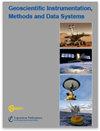Improving the Magic constant – data-based calibration of phased array radars
IF 2.3
4区 地球科学
Q3 GEOSCIENCES, MULTIDISCIPLINARY
引用次数: 0
Abstract
Abstract. We present two methods for improved calibration of multi-point electron density measurements from incoherent scatter radars (ISR). They are based on the well-established Flatfield correction method used in imaging and photography, where we exploit the analogy between independent measurements in separate pixels in one image sensor and multi-beam radar measurements. Applying these correction methods adds to the current efforts of estimating the magic constant or system constant made for the calibration of multi-point radars, increasing data quality and usability by correcting for variable, unaccounted, and unpredictable variations in system gain. This second-level calibration is especially valuable for studies of plasma patches, irregularities, turbulence, and other research where inter-beam changes and fluctuations of electron density are of interest. The methods are strictly based on electron density data measured by the individual radar and require no external input. This is of particular interest when independent measurements of electron densities for calibration are available only in one pointing direction or not at all. A correction factor is estimated in both methods, which is subsequently used to scale the electron density measurements of a multi-beam ISR experiment run on a phased array radar such as RISR-N, RISR-C, PFISR, or the future EISCAT3D radar. This procedure could improve overall data quality if used as part of the data-processing chain for multi-beam ISRs, both for existing data and for future experiments on new multi-beam radars.改进魔术常数--基于数据的相控阵雷达校准
摘要。我们介绍了两种改进非相干散射雷达(ISR)多点电子密度测量校准的方法。它们基于成像和摄影中使用的成熟的平场校正方法,我们利用了一个图像传感器中独立像素的独立测量与多波束雷达测量之间的类比。应用这些校正方法,可以对目前用于校准多点雷达的魔法常数或系统常数的估算工作进行补充,通过校正系统增益中可变、不可计算和不可预测的变化,提高数据质量和可用性。这种二级校准对于研究等离子体斑块、不规则性、湍流以及其他对电子束间变化和电子密度波动感兴趣的研究尤其有价值。这些方法严格基于单个雷达测量的电子密度数据,无需外部输入。当只有一个指向或根本没有用于校准的独立电子密度测量数据时,这种方法就特别有用。这两种方法都能估算出一个校正系数,然后利用该系数对相控阵雷达(如 RISR-N、RISR-C、PFISR 或未来的 EISCAT3D 雷达)上运行的多波束 ISR 试验的电子密度测量值进行缩放。如果将这一程序作为多波束 ISR 的数据处理链的一部分,那么无论是现有数据还是未来在新型多波束雷达上进行的实验,都能提高整体数据质量。
本文章由计算机程序翻译,如有差异,请以英文原文为准。
求助全文
约1分钟内获得全文
求助全文
来源期刊

Geoscientific Instrumentation Methods and Data Systems
GEOSCIENCES, MULTIDISCIPLINARYMETEOROLOGY-METEOROLOGY & ATMOSPHERIC SCIENCES
CiteScore
3.70
自引率
0.00%
发文量
23
审稿时长
37 weeks
期刊介绍:
Geoscientific Instrumentation, Methods and Data Systems (GI) is an open-access interdisciplinary electronic journal for swift publication of original articles and short communications in the area of geoscientific instruments. It covers three main areas: (i) atmospheric and geospace sciences, (ii) earth science, and (iii) ocean science. A unique feature of the journal is the emphasis on synergy between science and technology that facilitates advances in GI. These advances include but are not limited to the following:
concepts, design, and description of instrumentation and data systems;
retrieval techniques of scientific products from measurements;
calibration and data quality assessment;
uncertainty in measurements;
newly developed and planned research platforms and community instrumentation capabilities;
major national and international field campaigns and observational research programs;
new observational strategies to address societal needs in areas such as monitoring climate change and preventing natural disasters;
networking of instruments for enhancing high temporal and spatial resolution of observations.
GI has an innovative two-stage publication process involving the scientific discussion forum Geoscientific Instrumentation, Methods and Data Systems Discussions (GID), which has been designed to do the following:
foster scientific discussion;
maximize the effectiveness and transparency of scientific quality assurance;
enable rapid publication;
make scientific publications freely accessible.
 求助内容:
求助内容: 应助结果提醒方式:
应助结果提醒方式:


